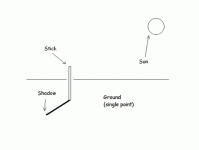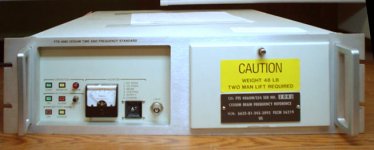Well, this idea of mine isn't actually for a true atomic clocke per-se.
However, the idea is to use a microwave signal generator and to decade it down to milliseconds, seconds, minutes, hours, days, weeks, months, and years.
I think that by decading a high accuracy source of around 4Ghz, I should get a very accurate second timer output.
The frequency standard I have in mind is an HP8616A signal generator. It is a cavity tuned industrial signal generator and I believe it will stay on a given frequency for a long time.
Does anybody have any ideas or comments about this idea?
Any circuitry ideas?
However, the idea is to use a microwave signal generator and to decade it down to milliseconds, seconds, minutes, hours, days, weeks, months, and years.
I think that by decading a high accuracy source of around 4Ghz, I should get a very accurate second timer output.
The frequency standard I have in mind is an HP8616A signal generator. It is a cavity tuned industrial signal generator and I believe it will stay on a given frequency for a long time.
Does anybody have any ideas or comments about this idea?
Any circuitry ideas?
"I believe it will stay on a given frequency for a long time."
Well, if that's all you know, how do you know it will be more accurate than, say, a $9,95 Japanese watch?
Look upo the accuracy of the signal generator, it will probably be given in ppm (parts per million) where 1000 ppm = 0.1%.
Then check up long term stability.
For ultimate requirements you can't do better then a radio-controlled/synchronised clock; these are in effect atomic-controlled.
However, if you want to have fun, go ahead and build your design.
Jan Didden
Well, if that's all you know, how do you know it will be more accurate than, say, a $9,95 Japanese watch?
Look upo the accuracy of the signal generator, it will probably be given in ppm (parts per million) where 1000 ppm = 0.1%.
Then check up long term stability.
For ultimate requirements you can't do better then a radio-controlled/synchronised clock; these are in effect atomic-controlled.
However, if you want to have fun, go ahead and build your design.
Jan Didden
Well, actually, my idea is after that of the clocks used by the NIST in colorado for the WWV UTC broadcast system.
I simply want to see if I can make a fairly accurate clock from this nice old sig gen I have sitting around, simply for something to do with it.
I haven't yet designed anything. I am just thinking up ideas right now and I believe it would be a very good project to attempt.
I simply want to see if I can make a fairly accurate clock from this nice old sig gen I have sitting around, simply for something to do with it.
I haven't yet designed anything. I am just thinking up ideas right now and I believe it would be a very good project to attempt.
Easy-peasy...
Here in Australia at least, many of the TV stations have their horizontal sync frequency (15,625Hz here) derived from a rubidium frequency standard, accurate to 2 parts in 10^11. Dangle a wire across the back of the TV, have a little tuned cct to get this frequency, multiply it by x64 with a 4046 phase locked loop for 1.00000000000 Mhz, (more or less)
Dangle a wire across the back of the TV, have a little tuned cct to get this frequency, multiply it by x64 with a 4046 phase locked loop for 1.00000000000 Mhz, (more or less)  then just do what you like from there. 😀 Worked for me. Just use a nice long settling time on the pll loop filter.
then just do what you like from there. 😀 Worked for me. Just use a nice long settling time on the pll loop filter.
Edit: Info was from a mid 70's Electronics Australia magazine, but probably still true enough.
Here in Australia at least, many of the TV stations have their horizontal sync frequency (15,625Hz here) derived from a rubidium frequency standard, accurate to 2 parts in 10^11.
 Dangle a wire across the back of the TV, have a little tuned cct to get this frequency, multiply it by x64 with a 4046 phase locked loop for 1.00000000000 Mhz, (more or less)
Dangle a wire across the back of the TV, have a little tuned cct to get this frequency, multiply it by x64 with a 4046 phase locked loop for 1.00000000000 Mhz, (more or less)  then just do what you like from there. 😀 Worked for me. Just use a nice long settling time on the pll loop filter.
then just do what you like from there. 😀 Worked for me. Just use a nice long settling time on the pll loop filter.Edit: Info was from a mid 70's Electronics Australia magazine, but probably still true enough.
Circlotron: Very interesting idea, I like that idea. Still, I want to see what I can do with this signal gen.
Rob M: I already have that.
Rob M: I already have that.
OEM GPS receiver boards provide a 1ms and 1s "tick" signal used in applications to update the screen synchronically to the UTC second.
Very accurate.
Very accurate.
how are we doing with those standards?
there is an EBay T&M for Calibration and Standards and rubidium oscillators, complete HP clocks go for $40 to $200.
for me, I just keep my HP3586C "Measurement Receiver" running all the time -- it has an ovenized oscillator and I can "beat it" to any receivable standard. I use the 10MHz clock to drive my HP5334B counter and HP3336B generator.
there is an EBay T&M for Calibration and Standards and rubidium oscillators, complete HP clocks go for $40 to $200.
for me, I just keep my HP3586C "Measurement Receiver" running all the time -- it has an ovenized oscillator and I can "beat it" to any receivable standard. I use the 10MHz clock to drive my HP5334B counter and HP3336B generator.
How about a microcontroller that can interface to tcp/ip protocol, wifi standard? you can receive it via a computer network via Network Time Protocol? Surely Maxim IC make something capable of this.
Interesting ideas there with the HP equipment.
Really what I'm looking for is to run a time base that originates at my premesis. Not from a radio source or internet.
I'm thinking of snatching a rubidium or cesium standard for sale if I can possibly find one for a good price.
Really what I'm looking for is to run a time base that originates at my premesis. Not from a radio source or internet.
I'm thinking of snatching a rubidium or cesium standard for sale if I can possibly find one for a good price.
Link
Hey DUO
I have a link to a page on lots of odd clocks that might be of some help to you (i hope) Bob
http://www.electricstuff.co.uk/mikesclocks.html
Hey DUO
I have a link to a page on lots of odd clocks that might be of some help to you (i hope) Bob
http://www.electricstuff.co.uk/mikesclocks.html
SY said:I have a design for a fusion-powered clock that you can build for yourself.
Tried it but it was inaccurate when changing from summer to winter time and the only place I could get it to show the time 24 hours per day was in the north of Sweden in the summer as the sun doesn't set there then.
It's a con..

Although advertised as fusion powered, the fusion is only for the back-light! The thing is actually mass/gravity powered...and it's going to slow downSY said:I have a design for a fusion-powered clock that you can build for yourself.

Bobcat: Thankyou, I like that site, it will help with creating a good display.
I have some nixie tubes so that would be an interesting display for such a clock as the one I intend to build.
I have some nixie tubes so that would be an interesting display for such a clock as the one I intend to build.
- Status
- Not open for further replies.
- Home
- General Interest
- Everything Else
- Howabout a DIY atomic clock?



